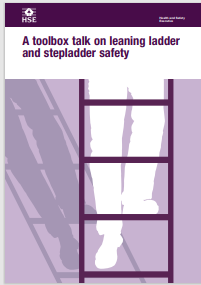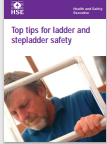|
|
Health and Safety INDG Industry Guides p4Send comments on this topic |
FREE QHSE Software Click <HERE> to Learn More |
||
QHSE Support >(Site Map) Health & Safety Guidance > H&S INDGs - Industry Guides >
" /> ">Useful INDG Health and Safety Guides - page 4
Related Links
•Health and Safety INDG Industry Guides p1
•Health and Safety INDG Industry Guides p2
•Health and Safety INDG Industry Guides p3
•Health and Safety INDG Industry Guides p5
•Health and Safety INDG Industry Guides p6
•Health and Safety INDG Industry Guides p7
Health and Safety Executive INDGs
INDG is an Acronym for Industry Guidance
Health and Safety INDG Industry Guides 401 to 422
> INDG 401 - Working at Height : Working at Height Regs 2005 - A Brief Guide
> INDG 402 - Safe use of ladders and stepladders
> INDG 403 - A toolbox talk on leaning ladder and stepladder
> INDG 404 - Drive Away Bad Backs
> INDG 405 - Top tips for ladder and stepladder safety
> INDG 408 - Clearing the air
> INDG 411 - A Short Guide for Clients on the CDM Regs 2015
> INDG 412 - Warehousing and Storage
> INDG 413 - Preventing falls from vehicles
> INDG 417 - Leading Health and Safety for Directors
> INDG 420 - Getting Specialist Health and Safety Help
> INDG 422 - Thorough examination of lifting equipment
Related Links
•Health and Safety INDG Industry Guides p1
•Health and Safety INDG Industry Guides p2
•Health and Safety INDG Industry Guides p3
•Health and Safety INDG Industry Guides p5
•Health and Safety INDG Industry Guides p6
•Health and Safety INDG Industry Guides p7
INDG 401 - Working at Height : Working at Height Regs 2005 - A Brief Guide
This brief guide describes what you, as an employer, need to do to protect your employees from falls from height. It will also be useful to employees and their representatives.
Following this guidance is normally enough to comply with the Work at Height Regulations 2005 (WAHR). You are free to take other action, except where the guidance says you must do something specific.
Falls from height are one of the biggest causes of workplace fatalities and major injuries. Common causes are falls from ladders and through fragile roofs. The purpose of WAHR is to prevent death and injury from a fall from height.
Work at height means work in any place where, if there were no precautions in place, a person could fall a distance liable to cause personal injury. For example you are working at height if you:
> are working on a ladder or a flat roof;
> could fall through a fragile surface;
> could fall into an opening in a floor or a hole in the ground.
INDG 402 - Safe use of ladders and stepladders
(withdrawn - archive copy)
Introduction
A third of all reported fall-from-height incidents involve ladders and stepladders – on average this accounts for 14 deaths and 1200 major injuries to workers each year. Many of these injuries are caused by inappropriate or incorrect use of the equipment. This guidance is to help employers:
•know when to use a ladder;
•decide how to go about selecting the right sort of ladder for the particular job;
•understand how to use it;
•know how to look after it; and
•take sensible safety precautions.
INDG 403 - A toolbox talk on leaning ladder and stepladder
(withdrawn - archive copy)
This talk can be used to help improve the competence of
workers using leaning ladders and stepladders across all
industry sectors. The talk is divided into three sections,
which can be given individually or together:
•hazards and pre-use checks;
•positioning;
•safe use.
INDG 404 - Drive Away Bad Backs
Mobile machine operators and drivers often report back pain. This can have many causes, not all related to work. But back pain may be made worse by driving for a long time in a poorly adjusted seat, jolting and jarring from rough roads (whole-body vibration) and by manual handling.
INDG 405 - Top tips for ladder and stepladder safety
(withdrawn - archive copy)
•Set-up for leaning ladders
•Leaning ladders in-use
•Set-up for stepladders
•Stepladders in-use
INDG 408 - Clearing the air
Every year, thousands of people in Great Britain die of lung disease or get asthma because of airborne contaminants they have breathed in at work. If your work produces dust (eg flour dust in bakeries), mist (eg paint mist from spraying), fume (eg from welding), gas (eg carbon monoxide from furnaces) or vapour (eg solvents from painting), there may be a risk to the health of your employees.
This leaflet is aimed at employers or anyone who installs LEV. Many employers install LEV to protect their workers’ health but it doesn’t always work effectively. It needs to be of the right type and properly installed, used and maintained. This leaflet advises on how to select the right LEV for your workplace and how to maintain it properly to help protect your employees.
Also see:
HSG 258 - Controlling airborne contaminants at work: A guide to local exhaust ventilation (LEV)
INDG 411 - A Short Guide for Clients on the CDM Regs 2015
This leaflet is aimed at you if you are a building owner, user or managing agent and are having maintenance, small-scale building work or other minor works carried out in connection with a business – as you will be a client with legal duties under the Construction (Design and Management) Regulations 2015 (CDM 2015).
Following the simple steps in this leaflet will help you meet your responsibilities as a client and ensure construction work and repairs are undertaken safely and without damaging worker’s and other people’s health.
What does CDM 2015 do?
Complying with CDM 2015 will help ensure that no-one is harmed during the work, and that your building is safe to use and maintain while giving you good value. Effective planning will also help ensure that your work is well managed with fewer unexpected costs and problems.
INDG 412 - Warehousing and Storage
This short guide is to help those involved in warehousing and storage to reduce the number of injuries and cases of occupational ill health. It contains simple advice that you should be able to apply to your business. You can find more information in Warehousing and storage: A guide to health and safety HSG76.
Causes of accidents
The main causes of accidents in warehousing and storage are:
> slips and trips;
> manual handling;
> work at height;
> vehicles in and around the warehouse; and
> moving or falling objects.
There may be other risks on your site that you should also consider.
INDG 413 - Preventing falls from vehicles
Advice to workers
More than 2000 serious injuries to people falling from vehicles are reported to HSE each year. Many of these injuries are broken arms or legs, resulting in weeks off work and possible loss of earnings. There are probably many more injuries that are not reported.
Also see:
INDG 199 - Workplace transport safety
INDG 382 - Road Safety - Managing Work Related (withdrawn - archive copy)
HSG 136 - Workplace transport safety: An employers' guide
HSG 144 - The safe use of vehicles on construction sites
INDG 417 - Leading Health and Safety for Directors
This guidance sets out an agenda for the effective leadership of health and safety. It is designed for use by all directors, governors, trustees, officers and their equivalents in the private, public and third sectors. It applies to organisations of all sizes.
INDG 420 - Getting Specialist Health and Safety Help
In many cases, businesses can manage health and safety themselves or with the help of in-house advisors. However, there are times when businesses will need to get external help, particularly on more detailed or technical issues. This is often referred to as specialist help.
Deciding exactly what help you need is very important. Unless you are clear at this stage, you probably won’t get the help you really need.
INDG 422 - Thorough examination of lifting equipment
Introduction
If you are an employer or self-employed person providing lifting equipment for use at work, or if you have control of the use of lifting equipment, you must make sure the lifting equipment is safe. The main requirements for you as a ‘duty holder’ are in the Provision and Use of Work Equipment Regulations 1998 (PUWER) and the Lifting Operations and Lifting Equipment Regulations 1998 (LOLER).
This leaflet provides advice on the options you have under LOLER relating to the requirement for thorough examination and inspection of lifting equipment and explains the benefits of having an ‘examination scheme’. However, this does not replace the necessity for operators to carry out checks to lifting equipment and accessories before use.
Also see:
INDG 290 - LORER 1998 : A Simple Guide
INDG 291 - PUWER 1998 : A Simple Guide
INDG 462 - Lift-truck training: Advice for employer
HSG 221 - Technical guidance on the safe use of lifting equipment offshore
ACOP L22 - Safe use of work equipment regulations
ACOP L112 - Safe use of power presses
Help file v2.276.407 : QHSE Support - Website On Safe Lines
onsafelines.com QHSE Software 2025 : Webmaster: Brian G. Welch MSc(QHSE), NVQ4(OH&S), CMIOSH














